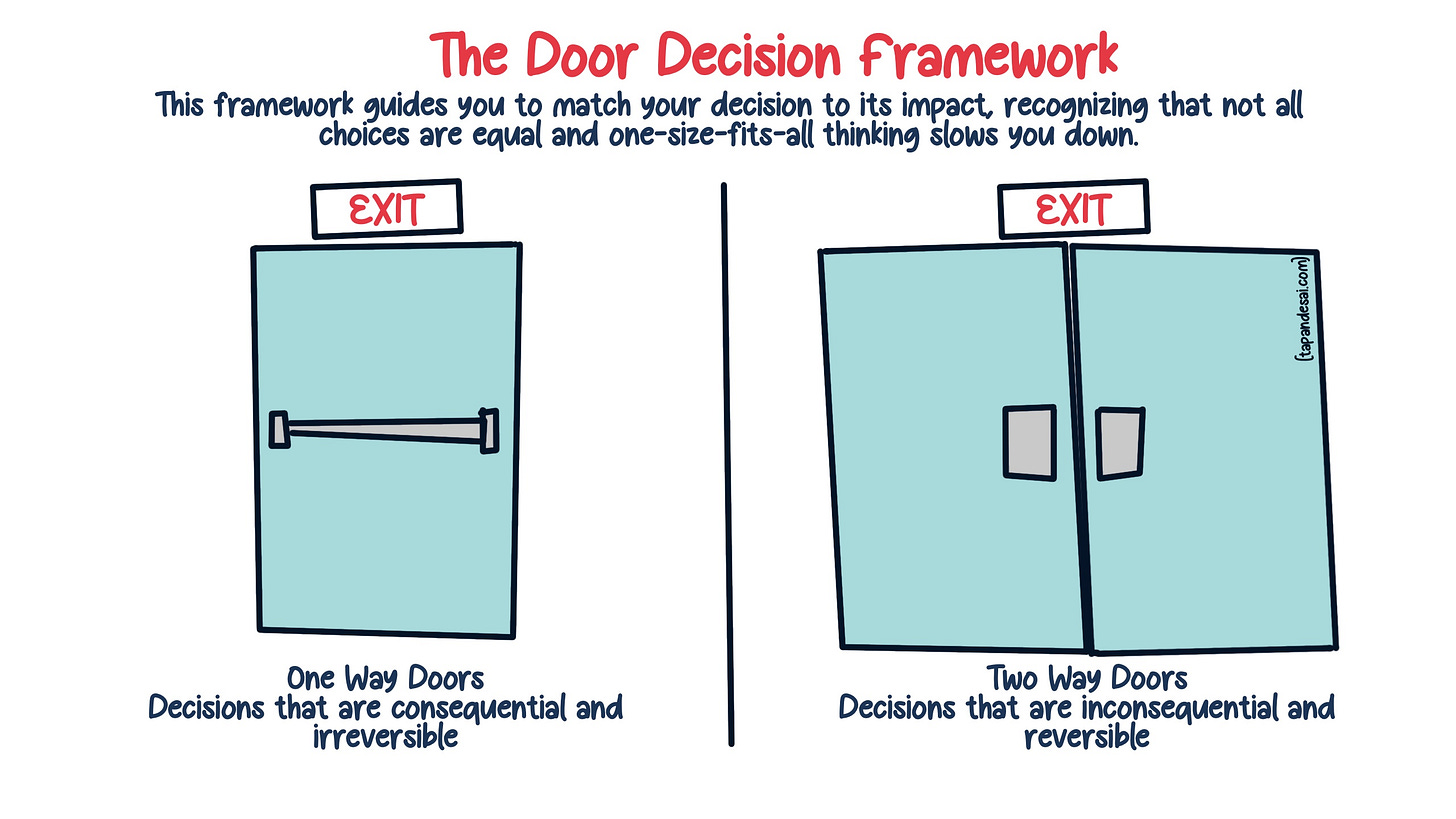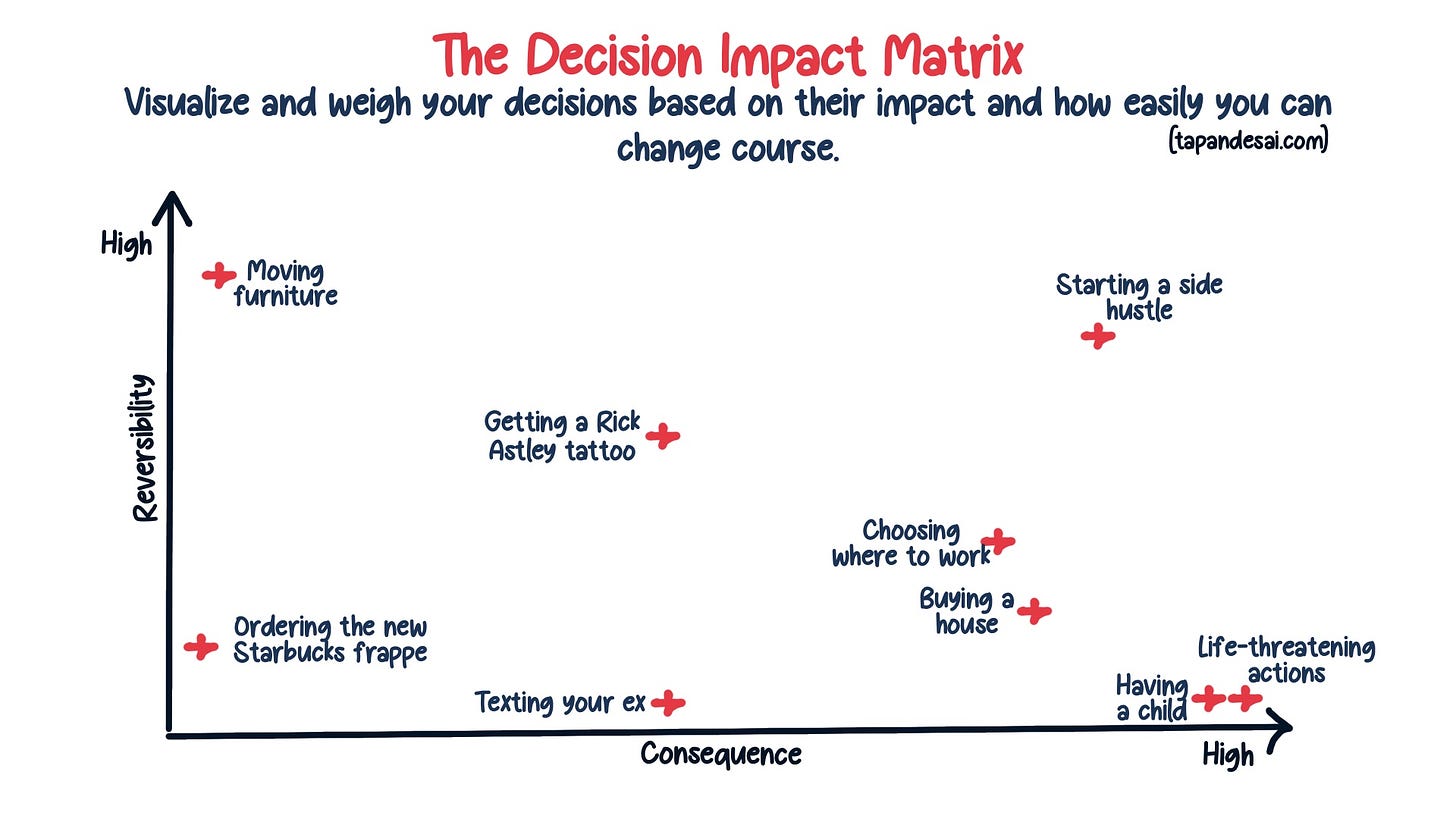Monthly Mulling💡
Fixing Your New Year's Resolutions with Incentives & Mastering the Door Decision Framework
Hi👋 Tapan here!
Wishing you a very Happy New Year! 🎉
📖 Currently, I am reading: Invent and Wander by Jeff Bezos, Walter Isaacson
Here’s the introduction from the book by Walter Isaacson which explains why I am reading it:
“I am often asked who, of the people living today, I would consider to be in the same league as those I have written about as a biographer: Leonardo da Vinci, Benjamin Franklin, Ada Lovelace, Steve Jobs, and Albert Einstein. All were very smart. But that’s not what made them special. Smart people are a dime a dozen and often don’t amount to much. What counts is being creative and imaginative. That’s what makes someone a true innovator. And that’s why my answer to the question is Jeff Bezos.”
🚪 Which Door to Choose? Navigating Life's Maze with the Door Decision Framework
Ever been caught in the "what's for dinner?" dilemma? I explained in my Paradox of Choice article that when I was visiting Florence, I was looking for restaurants after a hectic day. I had to choose from restaurants serving pizza, pasta, falafels, burgers, and yes, even gelatos! Each of them was top-rated and promised to be life-changing.
I chose a restaurant but later regretted, "Maybe there was something better out there."
Enter the Door Decision Framework, a neat trick to combat the Paradox of Choice, making the process of decision-making quicker and (hopefully) better.
But before moving forward, answer this:
Exploring the Door Decision Framework
Jeff Bezos popularized this framework, highlighting three key points in decision-making:
🚫 Not all decisions are created equal.
🐢 One-size-fits-all thinking in decision-making slows you down.
🤖 Mental bandwidth should be allocated based on the decision type.
So, what’s the Door Decision Framework about?
🚪 One-Way Doors
These are the biggies - decisions that are consequential and irreversible.
Once you step through, there's no easy return. They demand careful thought and deliberate analysis.
They are life-changing decisions; the cost of a mistake is high and can cause regret.
🔄 Two-Way Doors
These are everyday choices - decisions are inconsequential and reversible.
Make a decision, try it out, and if it's not working, simply backtrack.
If I had to map out the Door Decision Framework for average decisions in a life, it would look something like this:
Case in point: I bought a USB-C cable after an hour of meticulous research. It turned out shorter than I needed. Returned it the next day and grabbed another one without much thought. Could've saved an hour there – it was a classic two-way door decision! 🤦🏽♂️
Applying the Door Decision Framework
The Door Decision Framework cuts through analysis paralysis and the paradox of choice. If you know that a decision is reversible, the regret factor drops significantly.
Most of our life choices are actually two-way doors, but we often treat them like one-way doors.
You can backtrack the majority of your decisions.
Jeff Bezos points out that this is a common trap in large organizations where they use full-blown decision-making frameworks for a two-way door decision.
Shane Parrish provides two principles in his book Clear Thinking:
🏃♂️ ASAP Principle:
If the cost to undo the decision is low, make it as soon as possible.
For low-stake decisions (two-way doors), speed trumps deliberation.
Once you have a good option, just choose and move on! Engaging in any decision-making might be a waste of time, resources, and mental capacity.
My decision in Florence to pick a restaurant should have followed this principle.
🧐 ALAP Principle:
If the cost to undo a decision is high, make it as late as possible.
For high-stake decisions (one-way doors), careful analysis is key.
Gather all the information, weigh your options, and consider the long-term impacts using second-order thinking.
When the stakes are high, and there are no take-backs, you want to decide at the last moment possible, and keep as many options on the table as you can while continuing to gather information.
— Shane Parrish
✂️ Should You Ask Your Barber If You Need A Haircut? Mastering Resolutions with Incentives
New Year's resolutions notoriously fail 91% of the time. Why? Because we often overlook the power of incentives, relying too heavily on sheer discipline.
George Mack poses an intriguing question:
If the reward for completing New Year's resolutions was a billion dollars, and the consequence for failing was the death penalty – what % completion would New Year's resolutions have?
You have to build strong incentives for your resolutions to succeed.
As Charlie Munger puts it,
If you want ants to come, you put sugar on the floor.
Incentivizing Your Resolutions
To make your resolutions stick, you've got to craft some compelling incentives:
💪🏼 A publicly announced resolution that you'll run a marathon by year's end will probably get you fitter than a vague "hit the gym" goal.
💸 Posting on your WhatsApp group that you will treat them to $100 per person if you don’t make $100 online by June will help you work better on your side hustle.
📚 Pledge $50 to charity if you don't hit your 50 book-a-year reading goal
The above incentivises you to stick to your resolutions because of financial stakes, social shame, and the idea of having a bigger-than-yourself purpose.
Economics and Life 101
Here is the first, fundamental lesson of economics which applies to life: Incentives matter.
🚢 Take this wild fact: In the 1700s, 33% of British criminals shipped to Australia didn't survive the journey. So, how do you stop sea captains from killing criminals?
Britain switched from paying sea captains for every passenger who walked on the ship to paying them for every passenger who walked off. Immediately, the survival rate shot up to 99%!
Incentives are expert storytellers, able to convince you that nonsense is real, harm isn’t happening, value is being created, and whatever you’re doing is just fine.
— Morgan Housel
🐍 Incentives led to the rise in the Cobra population in India when the British tried to reduce it in the 1900s.
📜 Incentives caused the Dead Sea Scrolls to be torn into pieces in the 1950s.
👉🏽 Incentives were behind Wells Fargo employees opening millions of fake accounts to hit their targets in the 2010s.
And, incentives are the reason you should never ask your barber if you need a haircut.
Thank you for reading! 🙏🏽 Help me reach my goal of 3,000 readers in 2024 by sharing this post with friends, family, and colleagues who appreciate similar insights! ♥️
If you have any comments, you can connect with me on Twitter or reply to this email!








